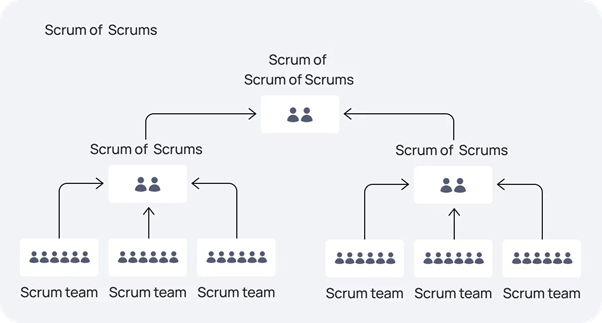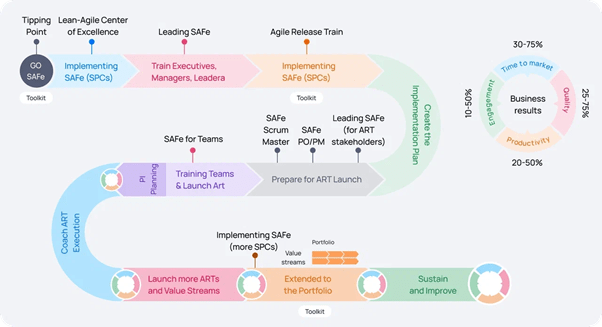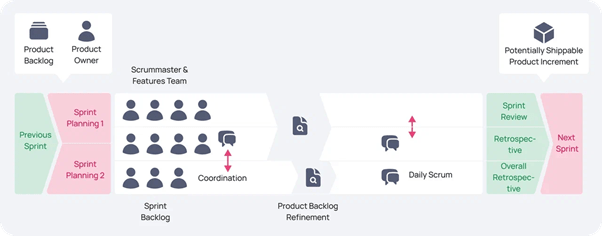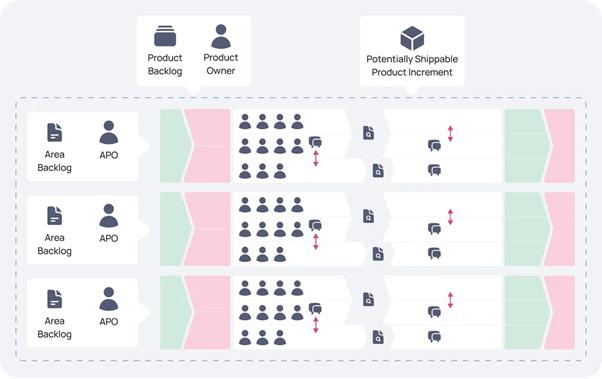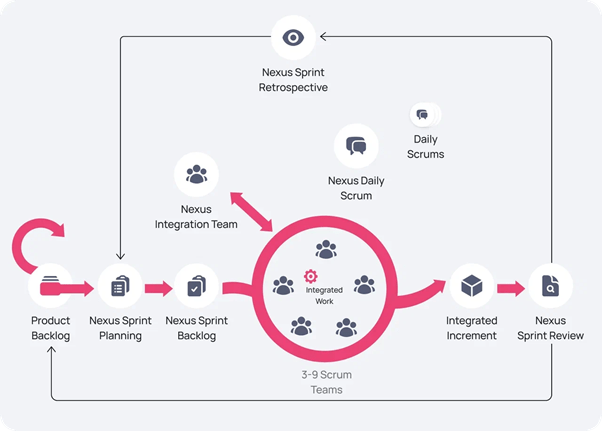How do you maintain the flexibility and speed of decision-making that characterizes small teams when the company has grown? Agile scaling frameworks help large and growing companies stay competitive with agile methodologies. We tell you why Agile is important to scale, what are some popular ways to scale, and how to choose the right framework.
What is Agile scaling
Scaling Agile is the process of extending agile development methodologies from the individual team level to the entire organization. The goal of this approach is to preserve the benefits of Agile when working on large projects involving multiple teams.
Imagine a small startup where a team of five people communicate easily, make quick decisions, and respond flexibly to customer requests. But what happens when the company grows to 100 employees? Will it be able to maintain the same speed and flexibility?
That’s exactly the challenge that Agile scaling solves. It helps organizations retain the spirit of innovation, responsiveness to change, and product quality while significantly increasing the size of the company. Scaling requires changes at all levels of the organization, from planning processes to corporate culture.
The basic principles of Agile scaling
Agile scaling is not just about increasing the number of teams, but a complex process of transforming the entire organization. To remain agile and efficient while growing, it is important to follow key principles. Agile across the organization requires adherence to several important principles:
- keep Agile values at all levels – agility must be throughout the company;
- transparent teamwork;
- autonomy of teams in decision making;
- regular synchronization between teams;
- adapt processes to the company – Agile is not a rigid manual, but a set of tools;
- improve not only the product, but also the way of working;
Why is it important to scale Agile?
With technological change and increasing competition, large companies must adapt quickly to new market conditions, but traditional management methods lack flexibility. Scaling Agile offers a solution to this problem, allowing large companies to maintain the speed and flexibility of startups, and here’s why it’s important:
- company stays competitive: large companies must remain agile to keep up with more agile competitors;
- product quality grows: the coordinated work of multiple teams allows for more complex and higher quality products;
- reduce product time-to-market: effective coordination between teams reduces development time;
- increases customer satisfaction: rapid response to changing needs enables better fulfillment of market demands;
- leaves “bunker mentality“: removing barriers between departments and streamlining processes improves the overall efficiency of the organization.
Popular frameworks for scaling Agile
When a company grows, simply applying Scrum or Kanban becomes insufficient. Special frameworks have been developed to coordinate the work of multiple teams. They help to keep Agile flexible even in large organizations.
Here is a brief overview of popular frameworks for scaling.
Scrum of Scrums (SoS)
Scrum of Scrums is the easiest way to scale Agile. SoS offers a solution for multiple teams working on the same product: create another team from each group.
This meta-team holds its own meetings to discuss what each team has done, what obstacles they’ve encountered, and what’s in the plans for the future. The main goal is to identify and solve problems that affect multiple teams. For example, if two teams share a common resource, the SoS can help avoid conflicts.
| SoS is especially useful when a company is just starting to scale Agile – the framework is easy to implement and does not require radical changes in the company structure.
SAFe (Scaled Agile Framework)
SAFe is one of the most popular frameworks for scaling Agile. It is often compared to a Swiss knife: many tools to solve different problems.
The SAFe framework consists of several layers:
- Team: the basic level where Scrum or Kanban teams work.
- Program: coordinates the work of multiple teams.
- Big Solutions: for companies developing complex systems.
- Customized Solutions: for companies developing complex systems.
- Portfolio: manages strategy and funding.
SAFe helps large organizations to align multiple teams, link company strategy to the daily work of developers, and manage dependencies between projects.
“SAFe is used for product portfolio management in large organizations. For example, in the banking sector, where multiple departments develop different products, SAFe helps to identify the relationships between products. This allows not only to manage a single product, but also to consider which functions can be borrowed from other teams and which tasks need to be worked on together”,
– Ksenia Filippova, SimpleOne SDLC product owner
However, SAFe has its critics – some believe that the framework is too complex and can lead to bureaucracy. Therefore, it is important to adapt SAFe to the needs of the company, rather than blindly follow all recommendations.
| SAFe is suitable for companies in which:
- more than 50 developers;
- are creating complex products;
- need to coordinate the work of several departments
LeSS classic (Large-Scale Scrum)
LeSS is a framework for companies that want to keep the simplicity of Scrum while working with multiple teams.
LeSS core principles:
- one product – one backlog – one product owner;
- up to eight teams work in one sprint;
- all teams participate in the overall planning of the sprint;
- daily meetings are held separately in each team;
- at the end of the sprint there is a general review and retrospective.
Instead of adding new roles and processes, LeSS extends existing Scrum practices. For example, instead of having separate sprint planning meetings for each team, LeSS offers common sprint planning for all teams working on the product.
Benefits of LeSS: easy to implement in teams familiar with Scrum; focus on the product rather than individual components; flexible to customize to the needs of a particular company.
| LeSS is suitable if:
- the company has up to 8 teams working on one product;
- need to keep Scrum simple;
- the company is ready for significant organizational change
LeSS Huge
LeSS Huge is an extension of the classic LeSS for very large projects. If there are more than 8 teams working on one product, you can turn to this framework.
The main differences between LeSS Huge and classic LeSS:
- The introduction of the concept of a Requirement Area, which is a large part of the product that requires the attention of multiple teams. For example, in a banking application, these areas might be Payments, Loans, Investments – each area has its own focus and set of functions.
- An example of a banking application would be Payments, Loans, and Investments.
- A product owner is assigned to each area – this person is responsible for prioritizing the work within his area. He works closely with the main product owner, but makes more detailed decisions for his area. This offloads the main product owner and provides more in-depth expertise in each area.
- The teams are grouped around requirement areas – they don’t work on random tasks from a general backlog, but focus on specific areas. The focus helps them dive deeper into the specifics of their part of the product, to better understand user and business needs in that area.
- One overall product backlog is maintained, despite the separation by area – this helps to maintain a holistic view of the product and ensure proper prioritization between different areas. The main product owner works from this common backlog, coordinating the efforts of all teams and areas.
For example, when developing a CRM system, some teams work on the sales module, others on analytics, and others on integrations. Each such large module becomes a requirement area in LeSS Huge.
Benefits of LeSS Huge: allows Scrum to scale to hundreds or even thousands of developers, keeps the focus on the product as a whole, makes coordination between teams easier.
Enterprise Scrum
Enterprise Scrum is a framework developed by Mike Beadle, one of the authors of the Agile Manifesto. It proposes to extend Scrum principles from the team level to the entire organization.
Features of the framework:
- focus on business value – instead of simply completing tasks, teams focus on creating measurable value for the business;
- flexible metrics – leaders can select and customize performance metrics to meet the needs of their organization;
- business owner role – this role replaces the classic product owner, empowering him/her with more authority and responsibility;
- scalable sprints – the duration of iterations can vary from a few days to several months, depending on the level of the organization;
- attention to organizational culture – Enterprise Scrum emphasizes the importance of creating an environment that supports innovation and continuous improvement.
Benefits of Enterprise Scrum: will help connect company strategy to the daily work of teams, increase transparency of business processes at all levels of the organization, accelerate decision making and response to market changes.
| Enterprise Scrum is suitable when:
- need to apply Agile principles not only in development, but also in other areas of the business;
- need a way to better connect the work of teams to the company’s business goals
Nexus
Nexus is a framework developed by Ken Schwaber, one of the creators of Scrum. The framework is designed to coordinate three to nine Scrum teams working on a single product.
Elements of Nexus:
- integration team – a group of specialists responsible for coordination between teams and merging work results;
- planning sprint, where representatives from all teams gather;
- a common sprint backlog that shows the dependencies between the teams;
- a daily meeting of team representatives to discuss progress and obstacles;
- review of sprint results by all teams;
- retrospective focusing on the interactions between the teams;
Benefits of Nexus: easy implementation for organizations already using Scrum, clear focus on integrating the work of different teams, minimal addition of new roles and artifacts.
Nexus is suitable for companies in which:
- have 3 to 9 Scrum teams working on a single product;
- need to keep Scrum simple while scaling;
- teams face challenges in integrating deliverables;
Nexus is not a one-size-fits-all solution, but it can be an effective tool for mid-sized organizations looking to improve coordination across teams without over-complicating processes.
The Spotify model
The Spotify model is not so much a framework as it is an example of how a large company has adapted Agile to its needs. The model attracts attention for its flexibility and innovative approach to team structure.
Elements of the Spotify model:
- Squads (Squads) are small cross-functional teams, analogous to Scrum teams. Each squad is responsible for a specific function or part of the product.
- Tribes (Tribes) – groups of several squads working in related areas. A tribe should not exceed 100-150 people.
- Chapters (Chapters) – groups of specialists of the same profile from different squads within a tribe. For example, all frontend developers or all testers.
- Guilds (Guilds) – communities of interest that unite people from different tribes. For example, a guild of security professionals.
Advantages of the Spotify model: the autonomy of teams develops, the balance between specialization and cross-functionality is maintained, and the company adapts flexibly to market changes.
| Consider the elements of the Spotify model if:
- needs to increase team autonomy;
- the company seeks a more flexible organizational structure;
- the company is willing to invest in developing a strong corporate culture
How do I choose the right framework?
Choosing a framework to scale Agile is a decision that will impact the entire organization. Here are a few steps to help you make the right choice:
- Assess the current state: how many teams are in the company, how familiar are they with Agile, what problems need to be solved?”
- Define scaling goals: e.g., improve coordination between teams, speed up time to market, improve product quality.
- Explore the features of each framework: e.g. SAFe is suitable for large organizations with multiple products, LeSS is good for companies that want to keep Scrum simple, Nexus is suitable if 3-9 teams are working on a single product.
- Assess readiness for change: some frameworks require deep organizational changes, others can be implemented gradually – it is worth choosing the right pace of change.
- Perform a pilot project: you can choose one or two frameworks to test, try them on a small group of teams and evaluate the results.
- Prepare to adapt frameworks: no framework will be perfect for the company, they can and should be changed and combined.
Frequently Asked Questions (FAQ)
Which framework is most effective for large organizations?”
For large organizations, SAFe (Scaled Agile Framework) is often recommended – it’s a structured approach to scaling Agile at an enterprise-wide level that is well suited for companies with hundreds or even thousands of employees working on multiple products. However, SAFe is not the only option. Some large companies have successfully applied LeSS Huge or an adapted Spotify model.
The choice of framework depends on different factors: the structure of the organization, the level of familiarity with Agile, the specifics of products and corporate culture. There is no one-size-fits-all solution. Even the most appropriate framework will require customization to meet the unique needs of the company.
The key to success is not blindly following the chosen framework, but adapting it properly. You can start with a pilot project that will allow you to evaluate the results and make changes. Scaling Agile is a continuous process of learning and adapting, not a one-time implementation.
What challenges can be encountered when implementing frameworks for scaling Agile?”
Resistance to change is one of the major challenges of scaling. Employees, especially middle managers, may fear loss of control and resist new ways of working. In addition, the existing corporate culture may be at odds with Agile principles, creating additional challenges.
Technical and organizational challenges also play a significant role. Coordinating multiple teams can be challenging, especially if they previously worked independently. Implementing new tools and practices can require significant investment, such as selecting and purchasing software and training employees in the right skills.
Some frameworks can lead to excessive bureaucratization, which goes against the very spirit of Agile. There is always a risk of getting caught up in processes and losing focus on what matters most – creating value for the customer. To overcome these challenges, it is important to start with pilot projects, invest in employee training, ensure management support and be ready to adapt the chosen approach to the company’s needs.
When is it wise to start using a framework to scale?
Typically, companies think about scaling when they encounter certain signs:
First, if there are more than three teams working on the same product and they have coordination problems. For example, teams often block each other’s work or duplicate tasks. In such cases, simple methods like Scrum of Scrums may not be sufficient.
Second, when individual teams successfully apply Agile, but at the organizational level, traditional management approaches persist. This creates a disconnect between the operational and strategic levels, preventing the full benefits of Agile from being realized.
Finally, if the company is growing and current processes are not scaling with it. Perhaps as the organization has grown, the speed of product output has decreased or the quality has gotten worse – this is a sure sign that it’s time to think about a structured approach to scaling.
Is it possible to combine different frameworks?
Yes, combining different frameworks is not only possible, but often desirable. Every organization is unique, and it’s rare that one framework is perfect for all needs.
A company can successfully combine elements from different approaches, for example, utilizing the team structure from the Spotify model while applying planning practices from SAFe. Or implement LeSS at the development level, but use Kanban to manage the flow of tasks across the organization.
To combine, you need a good understanding of Agile principles and company specifics. Combining allows you to use only those elements of frameworks that solve specific problems and experiment with changes.
Conclusion
Scaling Agile is a journey, not a destination. Every company is unique, so there is no one-size-fits-all recipe for success. It is important to choose the right framework, adapt it to your needs, experiment and combine different approaches. The main goal of scaling is to maintain flexibility and efficiency while growing the company and focusing on creating value for customers.
